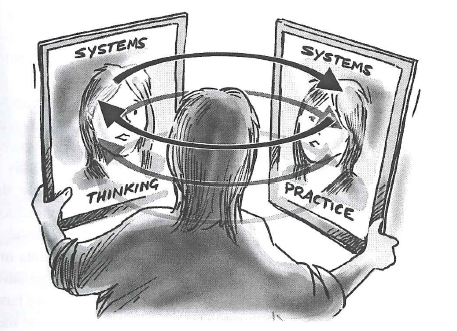4.1 The nature of systems thinking and systems practice
There are no simple definitions for either systems thinking or systems practice. It’s difficult to find definitions that capture all the perspectives that the ideas carry for people who think of themselves as systems thinkers and systems practitioners. Most systems practitioners seem to experience the same kind of difficulty in explaining what they do or what it means to be systemic in their thinking. Through experience I’ve developed some criteria by which I characterise systems thinking, but they seem to be quite loose in the sense that those characteristics are not always observable in what I recognise as systems thinking. In any case, they seem to be my list of characteristics, similar to, but not the same as, other people’s lists. This issue will be developed later but, for the moment, hold the idea that systems thinking and systems practice arise from particular ways of seeing the world.
Through interacting with the course and asking yourself questions about your experiences, you should discover at least some of these characteristic ways of seeing the world. If you have previously studied systems courses, you will already have experienced forms of systems thinking and perhaps ‘caught’ it in some way. You may even have developed your own understanding of systems thinking and what it means. If you have not studied systems thinking before, you need to be aware this course cannot make you into a systems thinker or a systems practitioner. It can only provide you with a framework through which you can develop your own characteristic ways of being a systems thinker and a systems practitioner.
Gather up your ideas of what these central ideas are in the following activity.
Activity 3 Systems thinking
Make notes on what you think are the main features of systems thinking.
This is not a test question. There are no right or wrong answers. You are simply being invited to explore what you already understand about systems thinking. Try to make your answer as comprehensive as you can.
If you have already studied systems thinking, you may find this task quite demanding because you will have to abstract these general ideas from what may be quite detailed understandings. Don’t be afraid to spend slightly longer on this if you need to.
If your only experience of systems thinking is through any background reading you may have done, you may want to base your answers directly on your recent reading. That’s fine but try to ensure that, in doing this activity, you are building your understanding and not just abstracting a list from someone else’s ideas.
Your notes from this activity will form a powerful basis from which to build your understanding of, and capacity for, systems thinking. You will develop your own ways of working with the notes you take as you work through the course. I prefer not to throw away any note, even if it gets superseded. It provides me with a record of my developing understanding, especially if I note down what I now understand and why I now think the old understanding is unhelpful. Even notes I think are redundant can prove to be the anchors for new insights.
Comment
My own answer to this activity follows. You should not treat this as the right answer. You should certainly not make judgements about your own performance in light of my response. My notes arise from my experiences, yours arise from your own. I would like to think you and I were both engaged in an activity that gives rise to new experiences and thus builds our own understandings from our own experiences. So I would much rather you treated the following as if we were in a conversation and use my ideas to develop your own.
The important features of systems thinking, as I see them, are these.
Systems thinking attends to the connections between things, events and ideas. It gives them equal status with the things, events and ideas themselves. So, systems thinking is fundamentally about relationship and process, a framework for understanding inter-relationships. It is often the relationships between things, events and ideas that give them their meaning. Patterns become important. The nature of the relationships between a given set of elements may be manifold. They may be causal (A causes, leads to, or contributes to, B); influential (X influences Y and Z); temporal (P follows Q); or relate to embeddedness (M is part of N). These relationships spring to mind immediately but there are many others, of course.
This attention to relationships between things, events and ideas means I can observe patterns of connection that give rise to larger wholes. This gives rise to emergence. Thinking systemically about these connections includes being open to recognising that the patterns of connection are more often web-like than linear chains of connection.
Systems thinking respects complexity, it doesn’t pretend it’s not there. This means, among other things, I accept that sometimes my understanding is incomplete. It means when I experience a situation or an issue as complex, I don’t always know what’s included in the issue and what’s not. It means I have to accept my view is partial and provisional and other people will have a different view. It means I resist the temptation to try and simplify the issue by breaking it down. It also means I have to accept there is more than one way of understanding the complexity.
Complexity can be quite scary. But it need not be: complexity becomes frightening when I assume I ought to be able to ‘solve’ it. Systems thinking allows me to let go of this notion and allows me to use a multiplicity of interpretations and models to form views and ideas about the complexity, how to comprehend it, and how to act purposefully within it. Essentially it is about using practical frameworks for engaging with multiple perspectives.
Systems thinking makes complexity manageable by taking a broader perspective. When I was studying science as an undergraduate, we were taught to break down situations into their component parts. This approach is so deeply entrenched in Western culture it seems natural and obvious to anyone brought up or educated in this culture that this is the way to tackle complex situations.
While this approach is powerful for some situations, it’s hopeless for others. For example, it now seems clear that climate change induced by human activity is likely to have major impacts on the planet, its physical environments, and its living organisms, including people. But all of these effects are so interdependent it is impossible to discover what the effects are likely to be by breaking the situation down.
Systems thinking characteristically moves one’s focus in the opposite direction, working towards understanding the big picture – the context – as a way of making complexity understandable. Most people recognise they have been in situations where they ‘can’t see the wood for the trees’. Systems thinking is precisely about changing the focus of attention to the wood, so that you can see the trees in their context. Understanding the woodland gives new and powerful insights about the trees. Such insights are completely inaccessible if one concentrates on the individual trees. In other words, systems thinking provides a framework for reflecting on boundary judgements.


